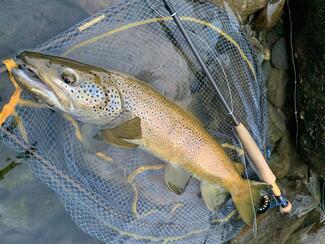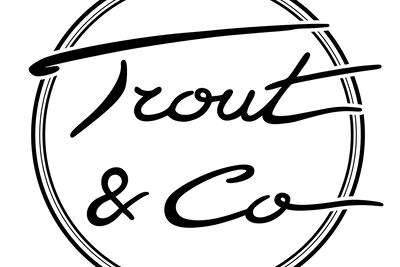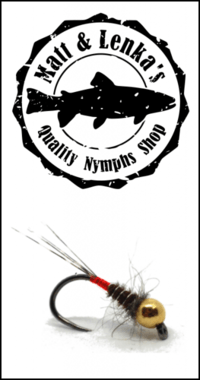“What is the best nymphing rod available at the moment?” This question is coming back very often on Trout & Co inbox. Our answer is always the same: “There is no best rod, they are all very different and each one of them will have its pros and cons for the various ways of nymphing”. This is absolutely not double talk, but more of an objective point of view according to what we can see with our tests since the beginning. Of course, we do notice differences in the ease of fishing between the different models, which are always linked to the couple action/strength of the rod. But in all the models we’ve tried, there is not a single one where the action/strength couple is failed. Some products are more adapted to a particular type of nymphing. They will suit best some of you according to your personal taste whether you prefer a fast action or a soft action. A very soft rod corresponds for many to the ideal euronymphing rod, but other anglers don’t consider them very pleasant. The best way to find out is to look at the data and compare the different references available on the market.
The advantage when we test rods in an objective way without any interests behind is that the data are irrefutable. Which is not the case when the review is only based on an angler’s experience. But those data still need to be interpreted in the right way and it’s not always an easy part. This is the main goal of this article: learn to put together the data you would find in our tests with your personal expectations in order to pick the right euronymphing rod for you.
The reflexion will be based on 4 main characteristics:
- The rod length
- The rod power
- The action
- The reactivity of the rod
The usage context in order to choose euronymphing rod
Before to get into the 4 points about a fly-fishing rod, we need to briefly discuss how is nymphing today.
What we mean when we talk about Euro-nymphing, consists in drifting one or two weighted nymphs in the current we guess occupied by trout to a certain depth. In the modern approach of this technique, or in the tandem dry/nymph, we do not back-cast with the fly line as we would when fishing with just a dry. The tippet length is a very important value. It has to be about twice the rod length in order to improve the drifts (see article about tippet construction). This assures that the fly line is not involved further than the rod tip while fishing. The cast consists in a unique flick of your wrist in order to send your nymphs without the implication of fly lie inertia.
For the majority of the situations encountered (fast current), the drifts are made with the rod tip high (with an inclination angle around 45°) in order to fish deep. During the drift, the nymphs are usually followed downstream by keeping this angle and taking back the exceed of line with the left hand. Keep in mind, the closest you fish, the more the rod inclination will tend to diminish and get closer to a horizontal position. Since the gesture is summarised, we can get into the main topic and see what would be the best nymphing rod for you. We need to keep one thing in mind :
The Rod’s Length
Mechanically, the longer the rod is, the easiest is it to keep natural drifts at a long distance. It allows a better control and doesn’t force to open the angle between the rod and the line too much which results into dragging.
This angle must always be around 90°. The choice of rod length the adapted is most of the time made according to 3 criteria.
The Fishing Distance
Obviously, the wider the river is, further you will have to fish I order and for that, you will need a longer rod. A long rod (above 10’) will allow you to keep your drift natural even at long distances. We can’t give you exact measurements about which rod length to fish at which distance. There is no rocket science about this matter because a whole lot of parameters are involved in this process. Among them, the depth of the current you’re fishing, its speed… For a same distance, the higher the couple speed/depth is, the more leverage you will need to keep control of your drift. Here are examples of known rod length used:
- 9’6 to fish small creeks, often tight and not wider than 5m
- 10’ for rivers not wider than 8m
- 10’6 for the average nymphing water, less than 15 m wide
- 11’ for any river wider than 15 m
Obviously, those data are just indicative, you can very well like using very long rods (11’) in any situation. The most important thing is to be comfortable with the gear you’re using, be accurate and not open the angle between the rod tip and the line too much. Which is often the case when using rod that is too short for the fishing distance.
Fisherman’s Length
It is a very often forget criterion, but it is a very important characteristic that will influence the drift. The ability to keep control of the drift is directly linked with your own size. And it will be very different from an individual that is 6’ tall and another that is 5’7. The shorter the fisherman is, the more he will need a long rod according to the type of water to compensate his leverage.
Necessity of Versatility
A longer rod will require more reactivity. This trait is measured in our protocol by the frequency of oscillation in CPM (CCF). It tends to diminish with the length and make the rod lose precision and comfort for dry fly fishing. So, it doesn’t matter too much if you only intend to do Euro-nymphing. But many people like to switch technique when a hatch occurs, for example. If you don’t want to carry a spare rod for that, it is quite important to keep in mind that there is an interest to use a relatively short rod according to the type of water you are fishing.
The rod’s power
As we said before, the power of the fly-fishing rod is an indicative data for euronymphing not only giving information about the weight of the fly line to use. In fact, as long as you don’t back-cast, the fly line is useless. Some even don’t use any fly line at all and fill up their reel with fluorescent nylon. It’s called the Spanish nymphing. Anyway, the real rod’s power of a nymphing rod (very often different from what’s announced by the brand which is why we make our tests) allows knowing what weights of nymphs are optimal to cast. This value of power influences the lightest weight you can use. The casts become harder and harder as you reach a certain size of bead for each type of power. To summarise and guide your choice if you fish with only one nymph (tungsten bead head) here are the minimum sizes of bead according to rod weights:
- #2: beads from 2 mm
- #3: beads from 2.4 mm
- #4: beads from 2.8 mm
Again, it’s only indicative values and a good nymph fisherman will be able to cast efficiently with a rod supposed to be too powerful according to the size of the bead used. Generally speaking, it is best to choose the power of your nymphing rod according to the type of fishing that you enjoy the most. For heavy nymphing (like in the Western USA involving fishing deep with large beads) a #4 or #5 is the most adapted. On the other hand, if you target graylings, or for fine low summer flow fishing, you’d do better with a #2.
The rod’s action
At Trout & Co, we measure the real rod’s action with the Action Angle (AA) in degrees. The faster is the rod (high AA), the more it will bend on a short distance from the tip. On the other hand, the slower is the rod, the more progressively it will bend on a much longer section of the blank while the traction takes place.
Nowadays, most of the models we tested had fast actions (AA superior to 66 degrees) and moderate fast (AA between 63 and 66 degrees) with a wide panel of values measured in those categories. Those differences can seem light, but you’d really feel them while fishing. A rod with an Action Angle of 72° (that we would qualify extra-fast) will have a very different action compared to a rod with a 68° AA that would also be classified as fast according to the official protocol of CCS. You must consider those differences when you pick your rod for euronymphing. We often specify the many advantages of the moderate-fast actions in our reviews. Whatever the fly-fishing technique, those rods will allow you to limit the snap and pulled out hooks even if you are using a very fine tippet, as long as there is no hard point on the blank.
However, rod that has a too slow action will have more trouble to do repetitive casts fast, including with heavy nymphs and properly cast in windy conditions. You would notice this effect on the cheaper models as well. Low-cost nymphing rods are often heavier and their progressive action is characterised by a loss of reactivity. It makes them not suited for dry-fly fishing at all (the reactivity is defined by the frequency of oscillation decreasing over progressivity).
In the same way, it is important to remember that a fast action rod is much more directional and so much more manageable and easier to use than a moderate-fast action. The moderate-fast action rods require more rhythm in the gesture and much more amplitude in the movement when casting to reach the target accurately. Despite those mechanic considerations, the personal taste for each fisherman will play a major part in the choice of the action. Some do prefer slow actions over fast, and some other only swear by moderate fast for the previous announced reasons.
Part of versatility in the choice of a nymphing rod
Switch efficiently between different fly-fishing techniques with only one rod includes making some compromises on some of the criteria. Indeed, in order to nymph well, a rod will require
- Enough length to control the drift
- A power correlated to the nymph’s weight
For dry-fly fishing, a rod will need
- A low BTW (to stay manageable and not exhaust the arm when back casting)
- Enough power to back cast the fly line in windy conditions
- An important reactivity to keep the casting rhythm high enough (frequency should be around 72/73 CPM to hope fishing properly with a dry fly)
Generally speaking, more a nymphing rod is “short” and powerful, let’s say from #3, the easier it will be to fish with a dry fly. As a matter of fact, the shorter the rod is, the more comfortable it is to fish and the more reactive is the rod, which helps to back cast properly.
So, we can only encourage you, if you want to switch from dry to nymph and vice versa with the same rod, to always choose the shorter rod as possible considering the type of water you fish (with taking care of not penalising nymphing too much). For information, to fish properly with a dry fly, you will need to not use a rod longer than 10’6 and reactivity inferior to 72 CPM.
A little trick to multiply the dry-fly fishing abilities of your long nymphing rod: try to underweight the rod using a fly line inferior to the indicated weight announced. For a 10’6 rod with a real power of #3/4, it will be easier to use a #3 for dry fly fishing instead of a #4 or 5.
Assessment of the description made by the brands and sellers with the data of the CCS and especially “progressive tip action”?
When can often read “fast and soft action, progressive rod” in the reviews from the brand managers about fly rods. They are pure marketing terms and they don’t mean anything to be honest. This kind of description tries to seduce and target as many people as possible, and mostly those feared of fast action rods and reassure them with the notion of progressivity. But this is an absolute nonsense scientifically speaking. A rod cannot be fast and soft action. As explained above, a rod’s action is measured with the Action Angle, characterised by a point, more or less close to the tip when we bend it. We can only encourage you to look for the Action Angle that would suit you best for a given rod length by trying several models.
“A good stock of power on the lower portion of the blank” is another very commonly used marketing sentence to describe a fly rod. And it is another nonsense. You would believe it means that this rod will be helpful to land bigger fish. At same real power, the faster the rod is, more the hard point is close to the tip. Which means there is an important reserve of power. The presence of this early hard point would theoretically mean fight can be easily managed.
However, we need to consider that on the contrary, the absence of hard point I the bend of the rod, thanks to the moderate fast action helps to get the fish exhausted quickly. The fact that the rod works on a longer part of the blank brings a “spring effect” and absorbs the fish energy. It destroys the constructor’s argument saying that you need a fast action to be able to land big fish.
“Ability to fight big fish on very fine tipper”. As previously announced, the ability to fight and land big fish efficiently on fine tippets is multiplied by the progressivity of the action and the diminution of the real power. At same power, more a rod is moderate, more it preserves the fine tippers by bending progressively during the fight.
So, if somebody tries to send you a 10’ #3 capable of fighting bug fish on very fine tippet and that our CCS data announce a real power #4/5 and an AA at 72° (a powerful rod extra fast) you have to have a second-guess !

In a nutshell, the redaction’s point of view is the following :
- For a multipurpose rod: a 10’ #3 or #4 with a fast action
- For fine low flow fishing: a #2 or #2/3 with a moderate fast or slightly fast action (length depends on the type of water you fish).
- For fine tippet and classic weights (bead head sizes): a #3 rod moderate fast or slightly fast (length still depends on the type of water fished).
- If looking for a heavy nymphing rod with the possibility to switch, or a multi-purposed rod for travelling, capable of versatility: a 10’#5 with fast action.
- To target big fish with standard weights: a #4 with moderate fast action or slightly fast (according to the type of water)
- If looking for a versatile rod to realise long drifts on large rivers: an 11’ #3 fast action.



